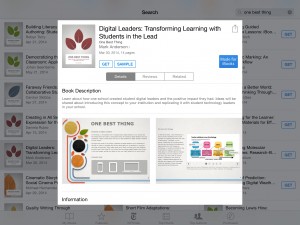The One Best Thing iBook Digital leaders: Transforming Learning with Students in the Lead is written by Apple Distinguished Educator, Mark Anderson.  Anderson discusses the advantages of creating a digital leaders program at a high school and how to go about doing so. First Anderson discusses the need for educators to go beyond the survival stage of technology use and move into the innovative stage. Anderson describes the survival stage when he writes, “At this level, educators are scared of breaking equipment, unsure of what to do with it, how to use it and what relevance it has to education”. Subsequently he describes innovation when he writes, “At this level, educators are fully digitally literate and have a sound understanding of pedagogy such as SAMR and RPACK, and how to successfully integrate technology into their learning pathways. They also share this knowledge and are likely to innovate in their schools and share these innovations using social media”. For students to become digital leaders, first educators must be able to integrate technology into the classroom for learning purposes. However, Anderson also created a way for student digital learners to help teachers master classroom technology. Digital leaders must complete so many tasks within the school to retain their position. Some of these potential tasks can be supporting teachers in their application of technology and guiding them in their employment of apps. However, Anderson says that the key to creating a successful digital leader program is allowing students to base their roles off of their interests and abilities. Other students can screencast how to use an app or write an article. Anderson also expresses the importance of stressing that digital leaders system should not be viewed as a club or as a club for geeks. He has implemented an application process for students to join the system. First students must create an application in “an innovative way using technology” and afterwards they are interviewed based on the quality of their application. By using an application system and having the leaders sign a contract; it holds the students to a high level of expectations as well as making the system prestigious and respected. This iBook by Mark Anderson presents a unique way for teachers to create a digital leader program. He includes personal examples and apps that can be used for the program. I believe that a digital leader program will help build students to use technology in the classroom to learn, improve the lives of others by promoting important causes, empowering others with no voices, and simply by being a positive influence. A digital leader program can be used within the agriculture classroom to create better advocates for the industry as well as fostering learning. I would highly recommend this iBook to teachers exploring the concept of digital leaders.
Anderson discusses the advantages of creating a digital leaders program at a high school and how to go about doing so. First Anderson discusses the need for educators to go beyond the survival stage of technology use and move into the innovative stage. Anderson describes the survival stage when he writes, “At this level, educators are scared of breaking equipment, unsure of what to do with it, how to use it and what relevance it has to education”. Subsequently he describes innovation when he writes, “At this level, educators are fully digitally literate and have a sound understanding of pedagogy such as SAMR and RPACK, and how to successfully integrate technology into their learning pathways. They also share this knowledge and are likely to innovate in their schools and share these innovations using social media”. For students to become digital leaders, first educators must be able to integrate technology into the classroom for learning purposes. However, Anderson also created a way for student digital learners to help teachers master classroom technology. Digital leaders must complete so many tasks within the school to retain their position. Some of these potential tasks can be supporting teachers in their application of technology and guiding them in their employment of apps. However, Anderson says that the key to creating a successful digital leader program is allowing students to base their roles off of their interests and abilities. Other students can screencast how to use an app or write an article. Anderson also expresses the importance of stressing that digital leaders system should not be viewed as a club or as a club for geeks. He has implemented an application process for students to join the system. First students must create an application in “an innovative way using technology” and afterwards they are interviewed based on the quality of their application. By using an application system and having the leaders sign a contract; it holds the students to a high level of expectations as well as making the system prestigious and respected. This iBook by Mark Anderson presents a unique way for teachers to create a digital leader program. He includes personal examples and apps that can be used for the program. I believe that a digital leader program will help build students to use technology in the classroom to learn, improve the lives of others by promoting important causes, empowering others with no voices, and simply by being a positive influence. A digital leader program can be used within the agriculture classroom to create better advocates for the industry as well as fostering learning. I would highly recommend this iBook to teachers exploring the concept of digital leaders.
Leave a Reply